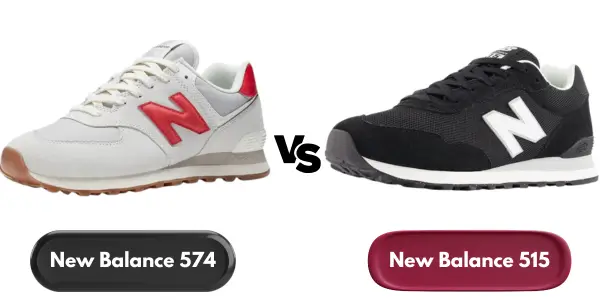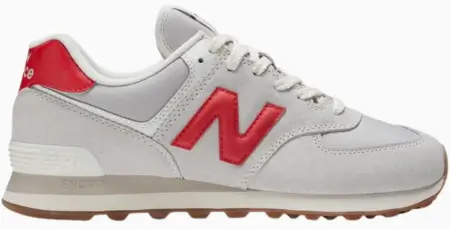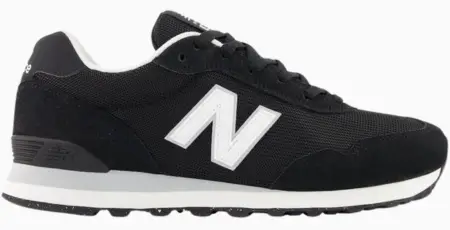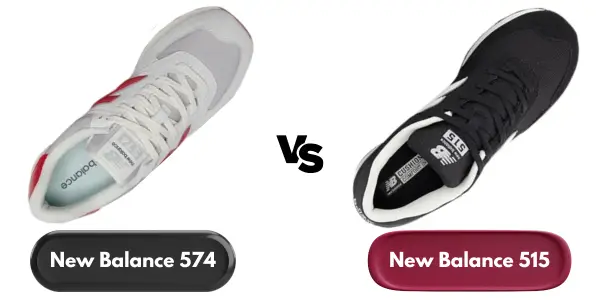New Balance 574 vs 515 Sneakers Comparison
Last Updated: January 01, 2025 | Author: Jake Thompson
In the grand universe of sneakers, the debate between the New Balance 574 vs 515 models is akin to an epic saga that continues to captivate enthusiasts and casual wearers alike.
As someone who's treaded many a mile in both, I've come to appreciate the nuances that set them apart.
Interestingly, New Balance's appeal spans various age groups, as highlighted in a recent Statista report.
The 515s, with their sleek design and lightweight feel, offer a contemporary twist on athletic footwear, while the 574s stand as a testament to New Balance's dedication to enduring style and comfort.

Each time I lace up either pair, I'm reminded that the choice isn't just about selecting a shoe—it's about choosing the companion for my daily journeys.
What becomes apparent is that the decision between the two isn't black and white; it's shaded with the subtleties of personal preference and purpose.
Stick around as I break down the characteristics that define these iconic models, and perhaps, by the end, we'll have unraveled the mystery of which sneaker reigns supreme.
Curious about more NB models? Compare the iconic 992 and 993 in our New Balance 992 vs 993 review
Table of Contents:
- Key Takeaways
- Table: New Balance 574 vs 515 Sneaker
- Pros & Cons
- Design
- Upper Construction
- Midsole & Outsole
- Comfort
- Cushioning
- Breathability
- Performance
- Durability
- Fit and Sizing
- Final Verdict
- Frequently Asked Questions
Key Takeaways
- - The New Balance 515 is part of the Classic collection and is suitable for daily routine and low-impact activities. It is known for its comfort and padded Achilles heel and collar entrance.
- - The New Balance 574 was introduced as a lifestyle shoe at a lower price point and has become a best-selling model for New Balance. It offers ENCAP cushioning, lightweight EVA foam cushioning, and a wide range of colorway options.
- - When shopping for New Balance sneakers, factors to consider include the purpose of the shoes, personal preference for cushioning and padding, material and sole durability, and style preferences.
- - New Balance has a range of sneaker models, with higher numbers indicating more technical shoes and lower numbers being more lifestyle-based. The New Balance 574 was introduced as an economy runner with a lower price point.
Table: New Balance 574 vs 515 Sneaker
 |
 |
|
|---|---|---|
| Feature | New Balance 574 | New Balance 515 |
| Collection | New Balance 574, New Balance ENCAP | New Balance Classic |
| Style | Classic, Retro | Sporty |
| Orthotic Friendly | ✓ | ✓ |
| Removable Insole | ✓ | ✓ |
| Material | Suede | Suede, Mesh |
| Inspired From | Running | Running |
| Top | Low | Low |
| Season | Spring, Summer | Spring, Fall |
| Closure | Laces | Laces |
| Weight | 340g | 286 g |
| Price |
Pros & Cons
New Balance 574
Pros:- - Durable with leather and suede construction.
- - ENCAP midsole for supportive cushioning.
- - Classic, versatile design with various color options.
- - Mesh upper for breathability.
- - Non-padded tongue can be uncomfortable.
- - Often runs small, sizing up may be necessary.
- - Slightly heavier due to more suede.
- - Generally more expensive.
New Balance 515
Pros:- - Lightweight due to Fresh Foam technology.
- - Flexible, adapting well to foot movements.
- - Modern design with a variety of colorways.
- - Good ventilation with mesh upper.
- - Moderate arch support may not be sufficient for some.
- - Potential durability issues with sole rigidity.
- - Inconsistent fit due to material mix.
- - Less cushioning compared to other models.
Design
When assessing the design of any running shoe, the upper construction is a critical element to consider.
The 515 sneaker's increased mesh material offers enhanced breathability, while the 574 sneakers' dominant suede detailing not only contributes to its classic aesthetic but also affects its overall durability.
Meanwhile, the midsole and outsole configurations play pivotal roles in the shoes' performance.
The 574 sneakers' ENCAP technology provides a firmer support structure compared to the softer, more casual support found in the 515 shoe sole design.
Upper Construction
The upper construction of a sneaker isn't just its most visible aspect, it's a critical component that dictates the shoe's overall breathability, fit, and durability. When I delve into the New Balance 515 vs 574, I immediately notice their thoughtful use of materials. Both models feature a suede and mesh upper combination, striking a balance between robustness and breathability.
The suede offers a touch of class and enhances durability, while the mesh upper ensures my feet stay cool, even on warmer days. The 574 shoes' traditional design is iconic, presenting a retro vibe with diverse colorways that appeal to sneaker aficionados.
Meanwhile, the 515 sports a more modern design, catering to those seeking a contemporary aesthetic. Both shoes' upper construction contributes to their long-lasting wear and stylish appearance.
Midsole & Outsole
Moving beyond the upper construction, it's essential to examine the midsole and outsole design, where the fusion of function and innovation in the New Balance sneakers becomes particularly evident. The midsole of the 574 utilizes ENCAP technology, combining a sturdy polyurethane rim with a soft EVA core, offering a balanced blend of cushion and durability. Conversely, the 515 features a simpler EVA foam midsole that provides ample cushioning for everyday wear.
The outsoles on both models are made of durable rubber, though their tread patterns may differ slightly to enhance grip and longevity. Let's break down their design nuances:
| Feature | New Balance 515 | New Balance 574 |
|---|---|---|
| Midsole | EVA foam midsole | ENCAP technology |
| Cushion | Comfort-focused | Balanced support |
| Outsole | Durable rubber | Durable rubber |
Each design choice reflects a commitment to ensuring that every step taken is a blend of comfort and stability.
Comfort
When it comes to comfort, both New Balance models tout their unique cushioning technologies: the 574 sneaker ENCAP midsole lends a firm yet supportive feel, while the 515's EVA foam offers a softer, more pliable cushioning experience.
I've found the breathability factor to be a game-changer, with the 515's additional mesh materials providing a noticeable advantage in airflow and comfort during extended wear.
Each sneaker's comfort attributes cater to different preferences, choosing between them as much about personal comfort criteria as style.
Cushioning
Cushioning, a critical factor for footwear comfort, varies significantly between the New Balance 515 and 574 models, with each utilizing distinct technologies to enhance the wearer's experience. The 574's ENCAP midsole provides a core of soft EVA foam cushioning, surrounded by a tough polyurethane rim for added support and durability. This combination offers excellent shock absorption and arch support, but it can take a bit of time to break in.
The 515, however, utilizes New Balance's Fresh Foam technology. This innovative foam cushioning system is designed to provide a plush, more immediate comfort, making the shoe feel incredibly soft and responsive from the get-go.
Here's a breakdown of their cushioning features:
| New Balance 574 | New Balance 515 |
|---|---|
| ENCAP technology | Fresh Foam cushioning |
| EVA foam midsole | Plush, immediate comfort |
| Arch support & durability | Soft and responsive |
| Rubber outsole for stability | Lightweight with great shock absorption |
Breathability
While discussing the comfort provided by cushioning technologies in New Balance 515 and 574 models, it's equally important to examine their breathability. This key factor significantly affects in-shoe comfort over prolonged periods of wear.
The 515's upper, crafted with a generous amount of mesh, offers excellent breathability, particularly around the toe box, making it a superb choice for those seeking a lightweight shoe that stays cool and airy.
In contrast, the 574 features a more traditional suede upper, which, while stylish, doesn't match the 515's ventilation capabilities. However, both shoes incorporate breathable elements, ensuring that sneakers don't become stifling.
The difference lies in their execution: the 515 prioritizes a breezier wear experience, a boon for active users who demand consistent airflow in their shoes.
Performance
Delving into performance, it's evident that both the New Balance sneakers offer distinct advantages for varying activities, with the 574 providing reliable support for short to moderate distances and the 515 excelling in comfort for everyday use.
When I analyze their capabilities, I focus on the following features:
- - Running Shoes: The 574's design lends itself to more structured running sessions, thanks to its durable build and additional support.
- - Lightweight Comfort: The 515 shines as a lightweight option, perfect for those who prioritize ease and a soft, orthopedic footbed.
- - Versatility: Both models feature a removable insole, facilitating customizable comfort for a range of activities.
In my experience, these attributes are crucial in determining the right footwear for my needs.
| Feature | New Balance 574 | New Balance 515 |
|---|---|---|
| Comfort | Good (not great for running) | Lightweight and more comfortable |
| Fit | Runs small (buy one size up) | True to size |
| Cushioning | ENCAP midsole (supportive and durable) | Fresh Foam (lightweight and ultra-cushioned) |
| Upper Material | Suede (less breathable) | Breathable mesh |
| Design | Iconic "OG Dad Shoe", varied colorways | Modern, versatile, stylish |
| Durability | Moderate (some wear issues reported) | High (cushioned heel and collar) |
| Flexibility | Moderate (scored 4/5) | Less flexible (scored 2/5) |
| Support | Moderate (with ENCAP technology) | Moderate (with fresh foam) |
Explore how the New Balance 990 stacks up against the 993 in our comprehensive comparison in New Balance 990 vs 993
Durability
In assessing the longevity of New Balance's 574 models, I've found that the materials and construction methods employed are pivotal to their enduring nature.
The detailed comparison of the New Balance shoes reveals that both models boast a versatile design, but they diverge in their approach to durability.
The 574's uppers are made of a suede and mesh combination, underpinned by a solid rubber outsole, enhancing its lifespan.
In contrast, the 515 features a lighter construction with more mesh, which sacrifices some robustness for a more comfortable fit.
However, both models exhibit a commendable level of durability, owed to New Balance's commitment to quality craftsmanship, ensuring that whichever model you choose, you'll have a dependable shoe for your daily wear.
Fit and Sizing

When it comes to the fit and sizing of New Balance 515 and the 574 sneakers, it's essential to note that both models are designed with the SL-2 last, which typically offers a wider forefoot and a deeper toe box, catering to those seeking extra room and comfort in their footwear.
- - Both models generally fit true to size, yet some users report the 574 runs small, suggesting sizing up.
- - The width options are a boon for those with wide feet; a pair of New Balance can accommodate various foot shapes.
- - Each sneaker comes with a removable insole, allowing for custom orthotics to be inserted for personalized comfort.
I find myself analyzing the nuances of each model's fit, considering the construction and how it affects my foot's relationship with the shoe.
Elevate your game with the best outdoor basketball shoes, including New Balance favorites in Best Outdoor Basketball Shoes
Final Verdict
In the face-off between New Balance 574 and 515, it boils down to your personal needs: the 574 wins for those seeking a classic, versatile sneaker with durable construction and balanced cushioning, perfect for everyday wear and light sports. On the other hand, the 515 is ideal for fans of lightweight, modern design, offering plush comfort and breathability for casual, everyday use. Ultimately, whether you lean towards the timeless appeal of the 574 or the contemporary ease of the 515, both models stand out as top-quality choices in the New Balance lineup.
Frequently Asked Questions
1. What are the key differences between the New Balance 574 vs 515 models?
The New Balance 515 and 547 are both popular shoes in the NB lineup, but they have distinct features. The 574 is often praised for its classic silhouette and versatile design, making it suitable for various athletic activities and everyday use. It's considered a classic, offering a combination of comfort and durability. On the other hand, the 515 shoes have a more streamlined look and are designed with a focus on lightweight comfort, ideal for those who prefer a low-profile shoe for everyday running and activities where repetitive impact might affect comfort.
2. Which shoe is better for running, the New Balance 574 or the 515?
When it comes to running shoes, the choice between the New Balance 515 and 547 depends on your specific needs. The 574, with its extra support and sturdy build, is versatile and can handle a variety of activities, including light running. However, if you're looking for a shoe specifically tailored for running, the 515 may be a better choice. It's designed to feel like you're 'walking on clouds,' offering a lighter experience and better responsiveness to 'feel the road.'
3. Are the New Balance 574 and 515 suitable for athletic activities beyond running?
Yes, both the NB shoes are designed for versatility beyond just running. The New Balance 574 is a versatile shoe suitable for a range of athletic activities, thanks to its durable design and supportive structure. The 515 also offers versatility but with a focus on a more streamlined, lightweight experience, making it suitable for daily wear and light athletic activities.
4. How do I decide between the New Balance 574 and 515 for casual wear?
For casual wear, both the 574 and the 515 sneakers are excellent choices, but they offer different aesthetics. The 574 is considered a classic with its vintage-inspired design and has a more pronounced "N" logo, giving it a distinctive New Balance brand look. The 515 is more low-key with a sleek, lifestyle sneaker appeal. Your choice may depend on whether you prefer the vintage, classic look of the 574 or the more modern, minimalist style of the 515.
5. What materials are used in the New Balance 574 and 515, and how do they affect comfort and durability?
The New Balance utilizes various materials, including leather, suede, mesh, and nubuck, contributing to their comfort and durability. The 574's design often includes a combination of suede and mesh, offering breathability and a sturdy structure, ideal for handling repetitive impact. The 515 may feature lighter materials like nubuck, enhancing its streamlined feel and making it a good option for those prioritizing lightweight comfort in their every day and running shoes. Both models incorporate these materials to support their respective designs for athletic and casual use.
Share this:







